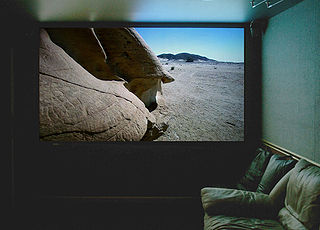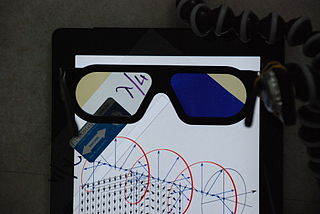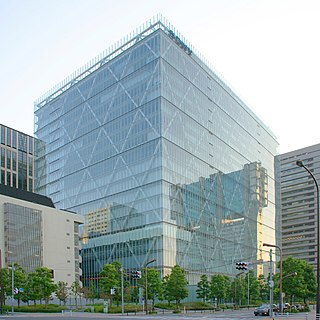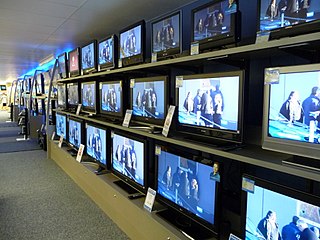Digital cinema refers to the use of digital technology to distribute or project motion pictures as opposed to the historical use of reels of motion picture film, such as 35 mm film. Whereas film reels have to be shipped to movie theaters, a digital movie can be distributed to cinemas in a number of ways: over the Internet or dedicated satellite links, or by sending hard drives or optical discs such as Blu-ray discs. Digital movies are projected using a digital video projector instead of a film projector. Digital cinema is distinct from high-definition television and does not necessarily use traditional television or other traditional high-definition video standards, aspect ratios, or frame rates. In digital cinema, resolutions are represented by the horizontal pixel count, usually 2K or 4K. As digital-cinema technology improved in the early 2010s, most of the theaters across the world converted to digital video projection.

Trinitron is Sony's brand name for its line of aperture-grille-based CRTs used in television sets and computer displays. One of the first truly new television systems to enter the market since the 1950s, the Trinitron was announced in 1968 to wide acclaim for its bright images, about 25% brighter than common shadow mask televisions of the same era. Constant improvement in the basic technology and attention to overall quality allowed Sony to charge a premium for Trinitron devices into the 1990s.

An overhead projector (OHP) is a variant of slide projector that is used to display images to an audience..

An LCD projector is a type of video projector for displaying video, images or computer data on a screen or other flat surface. It is a modern equivalent of the slide projector or overhead projector. To display images, LCD projectors typically send light from a metal-halide lamp through a prism or series of dichroic filters that separates light to three polysilicon panels – one each for the red, green and blue components of the video signal. As polarized light passes through the panels, individual pixels can be opened to allow light to pass or closed to block the light. The combination of open and closed pixels can produce a wide range of colors and shades in the projected image.

A video projector is an image projector that receives a video signal and projects the corresponding image on a projection screen using a lens system. All video projectors use a very bright light or laser to project the image, and most modern ones can correct any curves, blurriness, and other inconsistencies through manual settings.

DLP consists of chipsets based on optical micro-electro-mechanical technology that uses a digital micromirror device. It was originally developed in 1987 by Larry Hornbeck of Texas Instruments. While the DLP imaging device was invented by Texas Instruments, the first DLP-based projector was introduced by Digital Projection Ltd in 1997. Digital Projection and Texas Instruments were both awarded Emmy Awards in 1998 for the DLP projector technology. DLP is used in a variety of display applications from traditional static displays to interactive displays and also non-traditional embedded applications including medical, security, and industrial uses.

A television set or television receiver, more commonly called a television, TV, TV set, or telly, is a device that combines a tuner, display, and loudspeakers for the purpose of viewing television. Introduced in the late 1920s in mechanical form, television sets became a popular consumer product after World War II in electronic form, using cathode ray tubes. The addition of color to broadcast television after 1953 further increased the popularity of television sets in the 1960s, and an outdoor antenna became a common feature of suburban homes. The ubiquitous television set became the display device for the first recorded media in the 1970s, such as Betamax, VHS and later DVD. It was also the display device for the first generation of home computers and video game consoles in the 1980s. In the 2010s flat panel television incorporating liquid-crystal displays, especially LED-backlit LCDs, largely replaced cathode ray tubes and other displays. Modern flat panel TVs are typically capable of high-definition display and can also play content from a USB device.

Liquid-crystal-display televisions are television sets that use liquid-crystal displays to produce images. They are, by far, the most widely produced and sold television display type. LCD TVs are thin and light, but have some disadvantages compared to other display types such as high power consumption, poorer contrast ratio, and inferior color gamut.

A handheld projector is an image projector in a handheld device. It was developed to as a computer display device for compact portable devices such as mobile phones, personal digital assistants, and digital cameras, which have sufficient storage capacity to handle presentation materials but are too small to accommodate a display screen that an audience can see easily. Handheld projectors involve miniaturized hardware, and software that can project digital images onto a nearby viewing surface.
WEGA is a German audio and video manufacturer, manufacturing some of Germany's earliest radio receivers.

A polarized 3D system uses polarization glasses to create the illusion of three-dimensional images by restricting the light that reaches each eye.
The grating light valve (GLV) is a "micro projection" technology which operates using a dynamically adjustable diffraction grating. It competes with other light valve technologies such as Digital Light Processing (DLP) and liquid crystal on silicon (LCoS) for implementation in video projector devices such as rear-projection televisions. The use of microelectromechanical systems (MEMS) in optical applications, which is known as optical MEMS or micro-opto-electro-mechanical structures (MOEMS), has enabled the possibility to combine the mechanical, electrical and optical components in very small scale.

A projection screen is an installation consisting of a surface and a support structure used for displaying a projected image for the view of an audience. Projection screens may be permanently installed, as in a movie theater; painted on the wall; or portable with tripod or floor rising models. as in a conference room or other non-dedicated viewing space. Another popular type of portable screens are inflatable screens for outdoor movie screening.

A front projection effect is an in-camera visual effects process in film production for combining foreground performance with pre-filmed background footage. In contrast to rear projection, which projects footage onto a screen from behind the performers, front projection projects the pre-filmed material over the performers and onto a highly reflective background surface.
Laser color television, or laser color video display utilizes two or more individually modulated optical (laser) rays of different colors to produce a combined spot that is scanned and projected across the image plane by a polygon-mirror system or less effectively by optoelectronic means to produce a color-television display. The systems work either by scanning the entire picture a dot at a time and modulating the laser directly at high frequency, much like the electron beams in a cathode ray tube, or by optically spreading and then modulating the laser and scanning a line at a time, the line itself being modulated in much the same way as with digital light processing (DLP).
In electronics engineering, video processing is a particular case of signal processing, in particular image processing, which often employs video filters and where the input and output signals are video files or video streams. Video processing techniques are used in television sets, VCRs, DVDs, video codecs, video players, video scalers and other devices. For example—commonly only design and video processing is different in TV sets of different manufactures.
Liquid Fidelity is a "microdisplay" technology applied in high-definition televisions. It incorporates Liquid Crystal on Silicon technology capable of producing true 1080p resolution with two million pixels on a single display chip.

Large-screen television technology developed rapidly in the late 1990s and 2000s. Various thin screen technologies are being developed, but only the liquid crystal display (LCD), plasma display (PDP) and Digital Light Processing (DLP) have been released on the public market. A video display that uses large-screen television technology is called a jumbotron. These technologies have almost completely displaced cathode ray tubes (CRT) in television sales, due to the necessary bulkiness of cathode ray tubes. However, recently released technologies like organic light-emitting diode (OLED) and not-yet released technologies like surface-conduction electron-emitter display (SED) or field emission display (FED) are making their way to replace the first flat screen technologies in picture quality. The diagonal screen size of a CRT television is limited to about 40 inches because of the size requirements of the cathode ray tube, which fires three beams of electrons onto the screen, creating a viewable image. A larger screen size requires a longer tube, making a CRT television with a large screen unrealistic because of size. The aforementioned technologies can produce large-screen televisions that are much thinner.

Rear-projection television (RPTV) is a type of large-screen television display technology. Until approximately 2006, most of the relatively affordable consumer large screen TVs up to 100 in (250 cm) used rear-projection technology. A variation is a video projector, using similar technology, which projects onto a screen.














